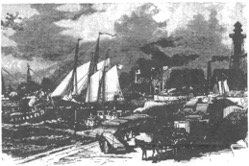SHIPWRECKS OFF HYDE PARK
From the October 1992 Edition of the Hyde Park Historical Society Newsletter by Jim Stronks
Jim Stronks, HPHS member, brings us some wonderfully interesting research about serious happenings right off Hyde Park's lake shore and some concurrent goings-on in the town as well. We are grateful to Jim/or his contribu tions (remember his follow-up on Brookins' prize-winning airplane flight?) to our store of Hyde Park history. lfyou have a story to tell, please share it with us.
One of our sister institutions is the Chicago Underwater Archaeological Society, an organization of scuba divers who locate and explore sunken ships. In a recent program at the Chicago Historical Society, their spooky underwater videos whetted my curiosity: were there shipwrecks in our Hyde Park waters? I found that there are indeed; they are lying out there this minute. I checked the divers' records against a variety of sources, especially old newspapers at Regenstein Library, to learn the story of these sinkings.
We do not realize the volume of shipping in Chicago's early decades. In one month, October 1869, four years after the Civil War, 1721 vessels docked in the Chicago River and its branches, sometimes double-parked. On November 15, 1869, which I cite solely because the microfilm of the Chicago Times happens to be legible for that date, no fewer than 119 ships put into Chicago in one day, and on some days there were over 300, most of them comparatively small ships, it is true. Most were sailing ships, that is under canvas, and of shallow draft, thus vulnerable to Lake Michigan's hard blows from the northeast, which broke many a ship against the western shore and sent others to the bottom with all hands lost. In fact, on the very next day, November 16, 1869, there were 35 sailing ships wrecked on Michigan and her sister lakes, plus ten steamers. Two days later the Times said the storm from the northeast "has been almost terrible beyond example," and reported a wreck not far from Hyde Park, at the foot of 35th Street, where the Ringgold had smashed ashore upon the property of the late Senator Stephen A. Douglas.
Most early wrecks were well north of Hyde Park because shipping was usually headed for the river, bringing in mountains of lumber and coal (and once a young woman from Holland who became my grand mother). Later, the rise of Gary and Calumet Harbor meant more ships passing Hyde Park, and some of these ended on the bottom too.
For example, did anyone here see the Tacoma sink off Jackson Park on November 4, 1929? Lying today in 32 feet of water, the Tacoma is a favorite of underwater archaeologists (I love that name) because most of her hull and deck, 73 feet long by 18 feet wide, remain intact. Her blunt proportions tell her role in life; the Tacoma was built, in Benton Harbor in 1894, to be a dredge tug. And on the day when "the ancient tub sprang a yawning leak," as the Tribune elegantly put it, she was plying her honest trade, pulling two scows at a point 1.1 mile from the 68th Str et crib. It was12:30, noontime, when her wooden hull spht open and Captain Fred E. Stubbins blew four blasts, a distress signal. The Coast Guard at Jackson Park heard, dashed out, and saved the crew of six, while another tug arrived to take over the tow.
(But the sinking of the Tacoma and the storybook rescue won only two inches at the bottom of page 2. By contrast, the Tribune gave reruns of breathless copy that day to the Chicago Civic Opera's first performance in tis new skyscraper home on Wacker Drive. Hyde Parkers who missed the gala "Aida" could have gone instead to see Loretta Young in "Fast Life" at the Piccadilly, adults only, or down to 63rd Street to see Lionel Barrymore in "Mysterious Island" at the Tower, or Richard Arlen in "Four Feathers" at the Maryland, or Claudette Colbert in ''The Lady Lies" at the Tivoli.)
Manitowoc in 1903, foundered and sank off 79th on April 24, 1918, when all the papers were delirious with war news
For a body of water seemingly so calm and beautiful, Lake Michigan has been a terror for killing ships and sailors, especially during that frightful autumn of 1929.
On September 9 the Andaste sank in a storm with 25 lives lost. On the 24th the ferry Milwaukee, loaded with 26 railway cars, went down in mid-lake with a loss of 52 lives. On the 29th the Wisconsin, combined freight and passenger, which had left Navy Pier for Milwaukee with a cargo of new automobiles, sank off Kenosha with 12 lives lost. On October 30th the Tribune summed up: "Three Shipwrecks on Lake Claim 89 Lives in Fifty Days"-but the lake was not finished. At noon on November 1, the freighter Senator, loaded with shiny new Nash cars, was rammed in the fog by the ore boat Marquette and sank in minutes off Port Washington at the cost of another 12 lives. Compared to these disasters, the sinking of the tug Tacoma four days later was small potatoes.
But it was big news when the majestic David Dows gave up the ghost off Jackson Park in 1889. A 5-masted barkentine of 1347 tons, 278 feet in length, 38 in beain, built in Toledo in 1881, the David Dows was designed to carry 140,000 bushels of grain from Chicago to eastern ports on the Great Lakes. On November 29, 1889, she was returning with 2053 tons of anthracite in bitter cold weather when, "SWEPT BY ICY GALES," her hold flooding, and "one mass of ice from stem to stern,'' she settled in 40 feet of water at 2:45 p.m. Her crew had time to lash themselves to the rigging, which extended well above the lake level, so were taken off safely by the tug Chicago. except that many of their severely frozen hands and feet would have to amputated. Later the Coast Guard dynamited the five masts sticking up out of the lake so as to clear that traffic lane for navigation, but the huge hull and deck, and some of the anthracite, are still down there right side-up and regularly visited by admiring scuba divers.
Four more shipwrecks off Hyde park have been mapped, but I have been unable to find their stories in the blurred microfilm of old newspapers. It is a matter of record that the schooner Hercules, 60 tons, the first known Lake Michigan wreck, went down 3/4 mile off what is now 63rd Street on October 3, 1818. The lumber schooner
McKay sank 3-1/2 miles off 51st Street in November 1856. The tug E. L. Anthony burned and sank off 59th Street on July 8, 1885. And the Teddy. a little 8-ton steamer built in.
But the shipwreck closest home, and truly a Hyde Park event in its day, was the death of the Silver Spray only 200 yards off 49th Street. There, on Morgan Shoal, on the north edge of what was called Chicago Beach, she met her end on July 15, 1914. Her pathetic remains are still visible from the shore today.
A strong northeast wind had pounded the lakefront with waves on July 14, and four Chicagoans had drowned, but the wind seems to have subsided and was apparently not a factor on the 15th. Whatever the cause, the helmsman of the Silver Spray would seem to have been- unaccountably, amazingly- ignorant of the Hyde Park Sands, that extensive cluster of shallows and sandbars clearly marked on every sailor's chart, visible from high-rise apartment windows, and marked by a red buoy today.
The Silver Spray. actually the fifth boat of that name on the Great Lakes, was built in Ludington in 1894 and had at first been gaily christened Bloomer Girl. She was a pleasure craft, as the Tribune called her, the kind which people rode from the Chicago River to the Columbian Expo in 1893, or which later they boarded at Navy Pier for a Sunday ride upon the lake. Pictures of such craft suggest that she probably fit Mark Twain's adjectives for another boat, "long and sharp and trim and pretty."
Specifically, Silver Spray was a wooden passenger steamer of 95 tons, 109 feet in length, 22 in beam, valued at $10,000-but uninsured at the time of her death. On that day she was running close to shore because she had been chartered to carry 200 University of Chicago students to Gary to see the steel mills. From exactly which pier they were to embark is unknown; perhaps some Society member can fill in the story for us.
No passengers were aboard when Silver Spray (nee Bloomer Girl) ran aground in only eight feet of water in full sight of hundreds of bathers at Chicago beach. A powerful launch from the life-saving station at Jackson Park harbor and two excursion boats were unable to pull her free-and then it happened. She turned over, and according to one account killed three crewmen. Sailors will tell you it is considered unlucky to change a boat's name.
(On July 16 the Tribune gave the event only two inches on page 4- "Bathers See a Shipwreck; Silver Spray on Reef'-and the Daily News said nothing at all. Not that the papers were preoccupied with the approach of World War
I. The guns of August would explode soon enough, but Hyde Parkers might still have gone to the movies that July night with a light heart, if they liked the jittery 2-reelers of 1914. Summer people at the Chicago Beach Hotel on 51st Street could walk two blocks west to the Beach movie house to see a Keystone Comedy and "The Night Hawks," an Essanay film probably shot in Chicago. The Hyde Park Theatre, at 5314 Lake Park, where the bank drive-in is now, was showing "Lillian's Dilemma" with Wally Van; the Jefferson, at 1523 East 55th, where the Deco Arts Building is today, advertised simply "Feature Photo Plays Daily," 5¢ and 10¢; and the Campus, at 1316 East 61st Street, was showing "Women Against Women.")
But to return to the wreck of the Silver Spray on Hyde Park Sands, eventually the lake tore her top off, then slowly beat her to pieces, but her heart lies out there yet, that is to say her boiler and propeller. Richardson's .
Chartbook and Cruisin Guide (1979) indicated that the wreckage extended above the surface. Today it lies ten inches below, but when the wind is right you can see the boiler heave into view, as big as a car, if you know exactly where to look and are patient. The best vantage point is looking straight out 200 yards from the "No Alcoholic Beverages" sign which is fifty paces north of the public telephone at 49th Street.
No buoy marks the spot, but on certain days when all the rest of Lake Michigan is quiet and smooth, you may be startled to see frothing white rollers mysteriously tumbling over each other for no visible reason at 49th Street. It is very striking. It seems a ghostly commotion. And indeed it marks the reef that killed the hapless Silver Spray. Hyde Park's own shipwreck.
Watch for it.



